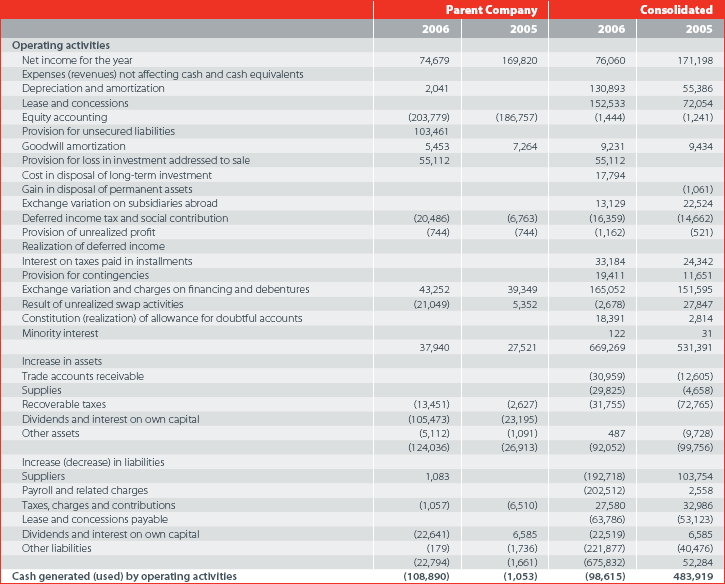 |

FINANCIAL INSTRUMENTS
On December 31, 2006, the Company and its subsidiaries had the following main financial instruments:
Financial investments: evaluated at cost, accrued of interest until the balance sheet date, the rates of which were compatible with market conditions prevailing on that date.
Investments: as described in Note 13, these refer to investments in closely-held subsidiaries and/or investments appraised at the equity method, representing strategic significance to the Company’s operations.
Significant balances with related parties: as described in Note 12, they are realized in normal market conditions.
Loans and financings: as described in Note 16, these include agreed charges and exchange swap effects, commented as follows, when applicable.
Debentures: the market value of the debentures issued by the Company and its subsidiaries approximates their face value on December 31, 2006.
The main risk factors affecting the Company’s and its subsidiaries’ businesses are as follows:
(a) Credit risk
The Company and its subsidiaries are potentially subject to credit risks arising from their trade accounts receivable, and the procedures adopted to minimize commercial risks include the selection of customers through adequate credit analyses, the definition of sales limits and short-term maturity of trade notes. Estimated losses with these debtors are fully provisioned.
(b) Exchange rate risk
The Company and its subsidiaries are subject to the effects of exchange rate fluctuations in connection with their foreign currency transactions.
To the extent that there are foreign currency-denominated debts, the Company and its subsidiaries, in order to protect its equity position in relation to fluctuations of the Brazilian currency, they contract currency swap operations (US$ x CDI - between 85% and 105%) for the total consolidated foreign currency-denominated debt (Note 16). The gains verified in such operations, amounting to R$1,633 for the period ended on December 31, 2006 (on December 31, 2005 – losses of R$23,176), additionally in December 2005, the parent company contracted hedge operation
to protect investments in Argentina against fluctuations of Peso against Real. The gain verified in the period amounts to R$12,907 (loss of R$4,671 on December 31, 2005), which was recognized as financial result.
LEASE
The indirect subsidiary Ferronorte is leaseholder with purchase option, by means of lease agreements.
These agreements position on December 31, 2006 is as follows:

PRIVATE SOCIAL SECURITY
The indirect subsidiary Ferrovia Novoeste sponsors a private pension plan with the company HSBC Fundo de Pensão. The plan has prevailing characteristics in the defined contribution modality during the funds accumulation period. The only defined benefit, in the accumulation stage, is a benefit equivalent to six salaries, paid in the event of death, disability and retirement process, calculated according to formulas and conditions established in the plan’s regulation.
The contributions are made on average, in the proportion of 80% by the sponsor and 20% by the active participants, as established in actuarial technical note.
The plan is reviewed by an independent actuary, annually, and the last version was concluded in December 2006.

The plan also has a defined benefit portion in the concession phase, whose actuarial liability refers to life annuities granted to its participants. The present value of the actuarial liability,calculated based on the mortality table AT-83 and on a financial discount rate of 6%, amounts to R$1,020 on December 31, 2006, totally coverage by financial assets.
In addition to the total financial coverage of actuarial liabilities, the plan has a surplus with which a pension fund that amounts to R$1,059 on December 31, 2006 was made. The Fund was established by remaining balances of contributions from the sponsor, coming from withdrawals of participants who made a partial redemption.
SUPPLEMENTARY INFORMATION - STATEMENT OF CASH FLOW

